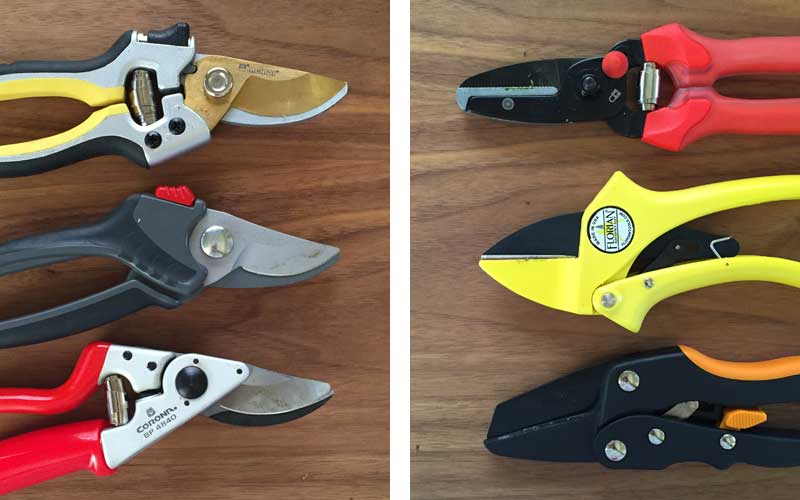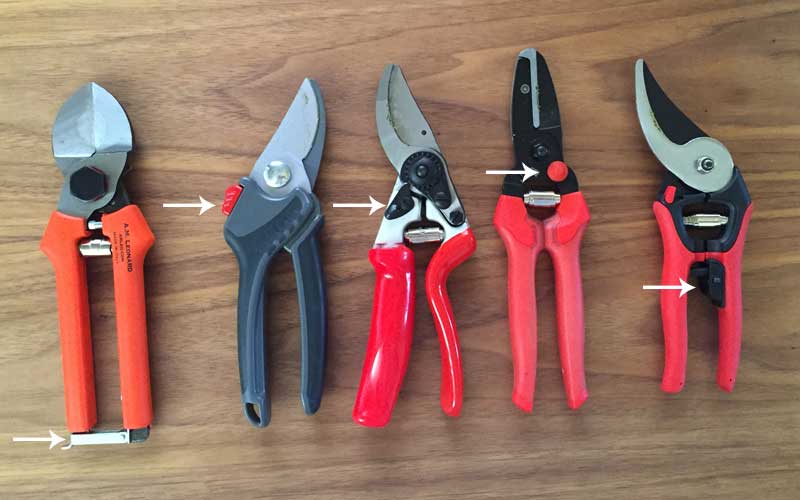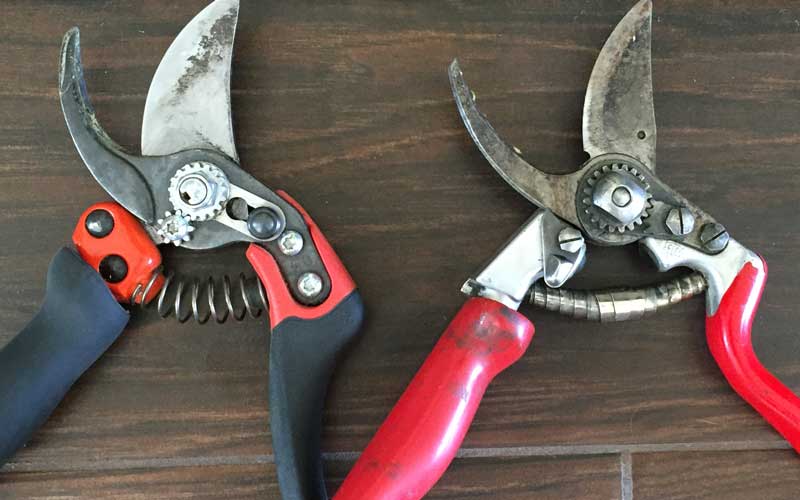Sudowoodo
New Member
Hey Everyone!
This is my first ever thread and post on this forum. I want to share my knowledge on Hand Pruners/Shears as well as provide a guide on selecting the right type of Hand Pruners/Shears.
I learned a lot about the basics of Hand Pruners/Shears thanks to Monica Hemingway, author of
"Best Hand Pruners / Pruning Shears: Guide & Recommendations 2017" (gardeningproductsreview.com).
Open suggestions, criticism, and improvements are greatly appreciated.
Pruners:
Pruners (also called clippers, pruning shears, or secateurs) are used to trim and shape plants, deadhead, prune out dead or damaged foliage and small branches, and cut back perennials. They’re one of the most-used gardening tools so it’s important to get a pair that works best for you.
Pruning tools come in a variety of styles and price points and it can be confusing trying to choose the right one. In this post, I will do my best to help consider which pruning shears so that you’ll know what to look for in choosing a quality tool.
How to Choose the Best Pruning Shears for You:
All Hand Pruner/Shears are not made equal for every single person. If there were one single type of Hand Pruner that is made for every single person, then there would only be one type across the market! Although there is not just one kind of pruning shear that’s perfect for everyone, after reading this guide I am sure choosing the best pruning shears will become effortless.
There are factors that predict which pruners are suitable for your needs such as hand size and shape, grip strength, and the amount of pruning you do. With these factors in mind, I have laid out some considerations when selecting Hand Pruner.
Important Considerations When Buying Pruning Shears
1. Type of Pruning Shears
There two basic types of pruners: bypass pruners and anvil pruners.

LEFT: Bypass pruners. RIGHT: Anvil pruners. Notice that bypass blades are curved while anvil blade are straight.
You’ll also find a third type of pruning shear, although it’s really a type of anvil pruner, rather than a separate class.
2. Availability of Replacement Parts
Not all pruners allow you to replace parts that break, wear out, or get damaged. The more expensive and higher quality pruners have replacements parts that are usually available directly from the manufacturer or distributor. In contrast, least-expensive pruners generally do not cover replacements parts because it is more cost-effective to simply replace the pruners rather than trying to make customers replace parts for an already least-expensive product.
In terms of intended use, there should be no reason to buy replacement parts as long as the hand pruner is used forthe right type of pruning.
3. Ergonomic Design
"A cutting tool is deemed ergonomic if it materially contributes to reducing the probability of cumulative trauma disorders with the hand, finger, wrist, or arm (tronextools). This type of design often includes soft-grip handles, angled blades, and a slightly curved shape. Pruners are also available with a rotating handle that turns with your hand as you open and close the handles. This is useful if your hand fatigues quite easily from pruning.
4. High Quality Steel Blades
Pruner blades are generally made out of steel. Sometimes they are coated with a non-stick substance that resists sap and other sticky materials. Look for blades made of high quality, hardened or carbon steel – they last longer and are less likely to nick or need frequent sharpening. Poorer quality blades don’t hold a sharp edge and can make pruning a laborious task that also damages plants.
Related to blade quality is how closely the blades pass as you open and close them; the closer the better. Quality pruning shears will allow you to adjust the tightness of the cutting mechanism and ensure that the blades are tightly held against each other.
5. Locking Mechanism
Most pruners have some sort of mechanism that allows you to lock it in the closed position. The locking mechanism does not only protect the blade when not in use, but it is can protect you from accidentally cuting yourself on a sharp blade.
Ssome mechanisms work better than others. Look for a latch that’s easy to open and close, doesn’t get in the way while you’re using the tool, and stays put when in the open or locked position. There’s nothing more annoying than having your pruning shears constantly locking up while you’re using them.

Examples of different locking mechanisms.
6. Strong Spring
Many pruning shears have a spring between the two handles that pushes the handles/blades apart when you relax your grip. This reduces the workload and hand fatigue.
There are two common types of springs: coiled metal and wire springs. Both work well, but look for one that’s tightly attached to the handles so it doesn’t accidentally pop off or get pulled off by branches when pruning trees or shrubs. Some brands, like Corona, have a spring-like system integrated into the cutting head so there’s no change of the spring getting caught or popping off.
Pruners without springs are more like scissors – they rely on your fingers to pull the handles apart with each cut.

Some pruners, like those from Bahco and ARS, usually have springs (left). Others, like Felco, usually have a metal coil (right).
7. Easy to Disassemble
Not all pruning shears can be taken apart for cleaning and to more easily sharpen the blades. Over time, sap, dirt, and other residue builds up on the blades and between the handles, making it harder to close and open the pruners. It’s easiest to clean your pruners if you can take them apart. Without taking pruning shears apart, you cannot sharpen the entire blade, resulting in warped blades after multiple sharpenings.
8. Size and Weight
Consider both how well the pruning shears fit in your hand and how large a diameter branch they can comfortably cut. Most pruners will manage about a ½” branch, but some can cut up to 1” or more. Don’t be tempted to cut larger branches though; it will be harder to make a clean cut and can cause wrist or finger strain.
If you’ll be doing a lot of pruning, check the weight of the pruners – heavier ones will cause more fatigue.
So Which Pruners Are Right For You?
First, think about what kinds of things you’ll be pruning. Are you trimming those branches, dead foliage, or cutting those perennials? Are you cutting those annoying deadheads? Do you need a heavy-duty tool that will cut through 1-inch wood, or will a light-duty pruner for flowers and small shrubs be enough? These questions are a good starting point to decide whether you need a bypass, anvil or ratcheting-anvil pruner.
Then determine your budget. Like most gardening tools, pruning shears come in a range of price points. While you typically get better quality at higher prices, it is not always necessary to pay more to get what you need for the right type of job. As long as you follow the important considerations that I have laid out above and each consideration matches which description is right for your specifications and needs, then you can still find the perfect Hand Pruner at a reasonably good price.
This is my first ever thread and post on this forum. I want to share my knowledge on Hand Pruners/Shears as well as provide a guide on selecting the right type of Hand Pruners/Shears.
I learned a lot about the basics of Hand Pruners/Shears thanks to Monica Hemingway, author of
"Best Hand Pruners / Pruning Shears: Guide & Recommendations 2017" (gardeningproductsreview.com).
Open suggestions, criticism, and improvements are greatly appreciated.
Pruners:
Pruners (also called clippers, pruning shears, or secateurs) are used to trim and shape plants, deadhead, prune out dead or damaged foliage and small branches, and cut back perennials. They’re one of the most-used gardening tools so it’s important to get a pair that works best for you.
Pruning tools come in a variety of styles and price points and it can be confusing trying to choose the right one. In this post, I will do my best to help consider which pruning shears so that you’ll know what to look for in choosing a quality tool.
How to Choose the Best Pruning Shears for You:
All Hand Pruner/Shears are not made equal for every single person. If there were one single type of Hand Pruner that is made for every single person, then there would only be one type across the market! Although there is not just one kind of pruning shear that’s perfect for everyone, after reading this guide I am sure choosing the best pruning shears will become effortless.
There are factors that predict which pruners are suitable for your needs such as hand size and shape, grip strength, and the amount of pruning you do. With these factors in mind, I have laid out some considerations when selecting Hand Pruner.
Important Considerations When Buying Pruning Shears
1. Type of Pruning Shears
There two basic types of pruners: bypass pruners and anvil pruners.
- Bypass Pruners: These are most popular. You get a clean cut from two curved blades that move past each other (hence ‘bypass’) just like a pair of scissors. One of the blades is sharp and cuts as it moves by a thicker unsharpened blade.
- Anvil Pruners: These have a one straight blade that cuts as it closes onto a flat edge (or ‘anvil’) – giving an action similar to a knife on a chopping board. They are usually slightly bulkier than bypass pruners which can make them tricky to get into tight areas. Because the blade often crushes stems when cutting (unless the blade is extremely sharp), these are best used on dead wood, rather than live plants.

LEFT: Bypass pruners. RIGHT: Anvil pruners. Notice that bypass blades are curved while anvil blade are straight.
You’ll also find a third type of pruning shear, although it’s really a type of anvil pruner, rather than a separate class.
- Ratchet Pruners. These have a clever extra mechanism to make light work of tough cuts. As you squeeze ratcheting pruning shears, they latch so you can release and squeeze again, performing the cut in easy steps rather than one go. It’s particularly good for those with less strength in their wrist, or for cutting thicker stems that regular shears cannot handle.
2. Availability of Replacement Parts
Not all pruners allow you to replace parts that break, wear out, or get damaged. The more expensive and higher quality pruners have replacements parts that are usually available directly from the manufacturer or distributor. In contrast, least-expensive pruners generally do not cover replacements parts because it is more cost-effective to simply replace the pruners rather than trying to make customers replace parts for an already least-expensive product.
In terms of intended use, there should be no reason to buy replacement parts as long as the hand pruner is used forthe right type of pruning.
3. Ergonomic Design
"A cutting tool is deemed ergonomic if it materially contributes to reducing the probability of cumulative trauma disorders with the hand, finger, wrist, or arm (tronextools). This type of design often includes soft-grip handles, angled blades, and a slightly curved shape. Pruners are also available with a rotating handle that turns with your hand as you open and close the handles. This is useful if your hand fatigues quite easily from pruning.
4. High Quality Steel Blades
Pruner blades are generally made out of steel. Sometimes they are coated with a non-stick substance that resists sap and other sticky materials. Look for blades made of high quality, hardened or carbon steel – they last longer and are less likely to nick or need frequent sharpening. Poorer quality blades don’t hold a sharp edge and can make pruning a laborious task that also damages plants.
Related to blade quality is how closely the blades pass as you open and close them; the closer the better. Quality pruning shears will allow you to adjust the tightness of the cutting mechanism and ensure that the blades are tightly held against each other.
5. Locking Mechanism
Most pruners have some sort of mechanism that allows you to lock it in the closed position. The locking mechanism does not only protect the blade when not in use, but it is can protect you from accidentally cuting yourself on a sharp blade.
Ssome mechanisms work better than others. Look for a latch that’s easy to open and close, doesn’t get in the way while you’re using the tool, and stays put when in the open or locked position. There’s nothing more annoying than having your pruning shears constantly locking up while you’re using them.

Examples of different locking mechanisms.
6. Strong Spring
Many pruning shears have a spring between the two handles that pushes the handles/blades apart when you relax your grip. This reduces the workload and hand fatigue.
There are two common types of springs: coiled metal and wire springs. Both work well, but look for one that’s tightly attached to the handles so it doesn’t accidentally pop off or get pulled off by branches when pruning trees or shrubs. Some brands, like Corona, have a spring-like system integrated into the cutting head so there’s no change of the spring getting caught or popping off.
Pruners without springs are more like scissors – they rely on your fingers to pull the handles apart with each cut.

Some pruners, like those from Bahco and ARS, usually have springs (left). Others, like Felco, usually have a metal coil (right).
7. Easy to Disassemble
Not all pruning shears can be taken apart for cleaning and to more easily sharpen the blades. Over time, sap, dirt, and other residue builds up on the blades and between the handles, making it harder to close and open the pruners. It’s easiest to clean your pruners if you can take them apart. Without taking pruning shears apart, you cannot sharpen the entire blade, resulting in warped blades after multiple sharpenings.
8. Size and Weight
Consider both how well the pruning shears fit in your hand and how large a diameter branch they can comfortably cut. Most pruners will manage about a ½” branch, but some can cut up to 1” or more. Don’t be tempted to cut larger branches though; it will be harder to make a clean cut and can cause wrist or finger strain.
If you’ll be doing a lot of pruning, check the weight of the pruners – heavier ones will cause more fatigue.
So Which Pruners Are Right For You?
First, think about what kinds of things you’ll be pruning. Are you trimming those branches, dead foliage, or cutting those perennials? Are you cutting those annoying deadheads? Do you need a heavy-duty tool that will cut through 1-inch wood, or will a light-duty pruner for flowers and small shrubs be enough? These questions are a good starting point to decide whether you need a bypass, anvil or ratcheting-anvil pruner.
Then determine your budget. Like most gardening tools, pruning shears come in a range of price points. While you typically get better quality at higher prices, it is not always necessary to pay more to get what you need for the right type of job. As long as you follow the important considerations that I have laid out above and each consideration matches which description is right for your specifications and needs, then you can still find the perfect Hand Pruner at a reasonably good price.




